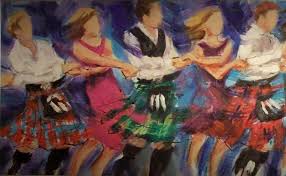
According to the Gregorian solar calendar, we’re about to begin welcoming a new year, which involves saying goodbye to the old one. Around my house, after installing a new roof, we’ve been moving furniture, cleaning closets, and going through files to determine what’s worth saving and what needs to be released. Keeping with this schedule and theme, one of those dedicated “necessary workers” we’ve relied on these past couple of years is installing a new water heater as I’m writing this. The original 16-year-old one ended its useful life last night.
Life is full of endings and new beginnings, which is why we need to get good at the Art of Grieving. Ceremonies and rituals like what happens across the globe on New Year’s Eve help us find grace and joy in these annual transitions. I think about the iconic song Auld Lang Syne which has become so much a part of New Year’s Eve celebrations, whether on screen or in real person gatherings. The song began as a Scottish folk song and a spritely dance to a faster tempo. It asks the question, ‘Should old acquaintance be forgot, and never thought upon?’ later changed to “never brought to mind?” The question encourages remembering that which is no longer present –a person, a place, a way of life, including the ancestors that courageously trod onward so that we could be here today. Rather than avoiding what we’ve lost, (and during these pandemic years we have lost much,), the song encourages remembering and honoring what’s gone –a practice at the heart of grieving.
The song was originally transmitted orally, and only written when Robert Burns sent a copy to the Scots Musical Museum in 1788, remarking that “it had never been in print…until I took it down from an old man.” Singing the song on New Year’s Eve became a Scottish custom that spread throughout the British Isles and when English, Welsh, and Irish people emigrated throughout the world they took the song along. Through the years in English speaking countries the song moved beyond New Year’s and came to symbolize endings and new beginnings included in funerals, and other memorials for the dead, at jamborees of the Scout movement, even played and sung on the last lowering of the Union Jack as a British Colony achieved independence. Partly due to the song’s pentatonic scale, (five notes per octave rather than seven) the song has become widely adopted in Korea, Japan, India, China, and other Eastern Asian countries, where its scale found a match with those countries’ music.
The dance that often accompanies the song reinforces the communal nature of needing support to grieve endings and embrace new beginnings. It provides encouragement while demonstrating how the arts of music, song and dance become tools for individual and collective transformation. The auld lang syne dance begins, as is common to many folk dances, with each person standing in a circle joining hands with the person next to them. At the last verse, everyone crosses their arms in front of themselves so that their left hand reaches the neighbor to their right and the right-hand joins to the hand of the neighbor on their left. When the song ends, everyone rushes to the middle, turns under their still joined arms, and the whole group ends up facing outwards. Still connected to one another, the dancers symbolically welcome what’s coming in their future new year.
One of my favorite lines from the song, repeated often in the chorus, seems a particularly relevant balm for our times. In this transition to a new year, join me as I lift my glass on behalf of your family and community and mine, “…we’ll take a cup of kindness yet, for auld lang syne. And may we have many more. Happy New Year!

